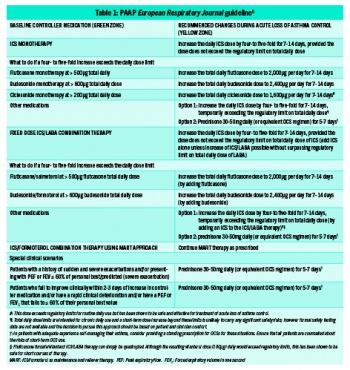RESPIRATORY
Effective asthma self-management
Personalised asthma action plans (PAAPs) are of great value but are underutilised as a strategy to improve asthma outcomes
June 4, 2021
-
Asthma is a major source of ongoing morbidity and mortality in Ireland. It affects about 890,000 patients in Ireland at some stage and costs the state €472 million per year.1 The UK review of asthma deaths brought home some stark realities for those of us involved in asthma care, including continued over-reliance on ‘blue’ inhalers, failure to recognise the severity of the situation and lack of self-management instructions.2
One aspect of care that stands out is the use of personal asthma action plans (PAAPs) and the fact that they remain underutilised as a strategy to improved asthma outcomes. PAAPs have been shown to reduce hospitalisations by 15-54% and ED visits by 18-46%,3 improve quality of life and asthma control and reduce absenteeism from work or school by 21%. Despite the large body of evidence in favour of PAAPs and consistent recommendations by all guidelines, studies show that only 4% of GPs reported consistently providing a PAAP and only 2%-30% of patients actually receive one. It is projected that widespread introduction of PAAPs in Ireland would result in a reduction of between 24,000 and 61,000 ED visits and a potential saving of €27-€54 million per year in healthcare costs and up to €48 million in indirect costs dues to absenteeism.1,4
Self-management has been defined as the tasks that individuals must undertake to live with chronic conditions, including “having the confidence to deal with medical management, role management and emotional management of their conditions”. The literature suggests that an optimal self-management strategy includes education about the condition, self-monitoring and a written PAAP.
The barriers to the introduction of PAAPs include lack of time and experience in their use and delegating the job to equally inexperienced healthcare professionals who may not have received training in how to instruct patients in using PAAPs. In one study, only 30% of GPs attending an asthma workshop were able to prepare an adequate PAAP.5
The new Chronic Disease Management Programme in general practice is an opportunity to introduce a PAAP to patients with asthma and it can be included in the care plan for these patients. There is some ambiguity about PAAPs and many healthcare professionals are unsure about what and how to advise patients with asthma. A large review of the various PAAPs around the world showed large variability in both content and format, as well as poor usability. Most plans were developed ad hoc and by content experts exclusively. Most doctors do consider PAAPs to be important but often cite a lack of time as a major barrier to their implementation. The Irish PAAP can be downloaded from www.asthma.ie and is also in the new ICGP asthma guidelines (on www.icgp.ie) (see Figure 1).
The PAAP is based on a traffic light system:
- Green: good control. Minimal symptoms and PEF > 80%
- Amber: control suboptimal and need to alter asthma treatment
- Red: serious deterioration in asthma control and need to seek urgent medical care. The red zone is where the inhalers are not giving relief; there is difficulty in talking and breathing with a tight chest. The PEF is less than 60%.
The green and red zones are easy to understand and are relatively easy to put into action. The amber zone is where the ambiguity arises, as it involves upping the dose of inhaled steroids and/or using oral steroids to prevent further deterioration. There is much ambiguity about how to actually increase the ICS dose and this is further complicated with patients on fixed dose (ICS /LABA) regimes. There is a lack of clarity about what practical steps to take in the amber zone. The basic premise is to quadruple the dose of ICS despite where this temporarily exceeds the maximum dose of ICS. Doubling ICS has not proved to be effective.
Some patients need to be given a course of oral steroids to be used when their symptoms deteriorate. These patients are advised to seek medical attention when they start oral steroids. Patients who may need oral steroids include those who historically have not responded to increasing ICS and those with a history or severe or sudden deterioration in asthma.
A recent review in the European Respiratory Journal gives an excellent easy-to-use guideline to assist healthcare professionals when putting PAAPs into action (see Table 1).6
 (click to enlarge)
(click to enlarge)
